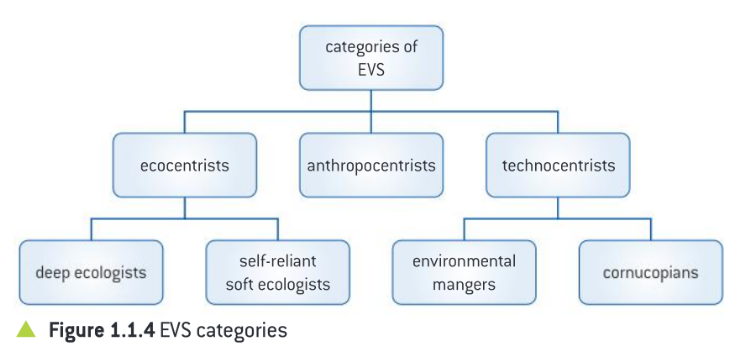1.1 - Environmental Systems
1/15
Name | Mastery | Learn | Test | Matching | Spaced |
|---|
No study sessions yet.
16 Terms
Environmental Value System (EVS)
A worldview or paradigm that shapes the way an individual, or group of people perceives and evaluates environmental issues and is influenced by cultural, religious, economic, and socio-political context
Who are involved in environmental movements?
Influential Individuals - Rachel Carson (Silent Spring), Al Gore (an Inconvenient Truth)
Independent Pressure Groups - Greenpeace on Arctic exploration, World Wildlife Fund (WWF) on saving tigers
Corporate businesses - MNC (multinational corporations) are involved as they are supplying consumer demand and in doing so, using resources and creating environmental impact (mining for minerals or burning of fossil fuels)
Governments - Make policy decision including environmental ones (eg. planning permission for land use) and apply legilisation to manage over the country.
Intergovernmental bodies - the United Nations have become highly influential in more recent times by holding Earth Summits to bring together governments, NGOs, and corporations to consider global environmental and world development issues.
Key dates in the environmental movement timeline
Early 1800s - Industrial revolution
1940s - 1960s - Green Revolution (mechanized agriculture, resource use and waste production rocketed, world population increased to about 3 billion)
1960s onwards - Modern environmental movement (impacts became more global, collapsing fish stocks, endangered species, deforestation)
April 22, 1970 - First Earth Day led by Senator Gaylord Nelson
1971 - Greenpeace was founded
Earth Day
An annual celebration on the 22nd of April that was originally celebrated in the year 1970. Sen. Gaylord Nelson and Denis Hayes organised the first ______ with 20 million people attending in the U.S. This event reinforced support for legislation like the Endangered Species Act (1973) and the Clean Air Act.
Silent Spring
Rachel Carson’s book published in 1962 warned about the effects of pesticides on insects, both pests and others, and how this was being passed along the food chain to kill others, including birds.
Initially, chemical industries tried to ban the book however, J.F.K ordered an investigation which promptly led to DDT being banned
What did Silent Spring discuss?
Believed that DDT (a POP, persistent organic pollutant) was accumulating in fatty tissues, causing higher risks of cancer for peoples.
When did Chernobyl happen?
April 26, 1986
What happened at Chernobyl?
A surge of power destroyed Unit 4 of the nuclear power station during a test. Afterwards, helicopters were used to pour sand and boron on the debris. The sand was to stop fire and release of radioactive material while boron was to prevent any nuclear reactions. To temporarily stop the further release of radioactive material, a concrete structure named Sarcophagus that covered the entire area was made.
The sarcophagus was considered a temporary fix to filter out radiation from the gases before the gas was released into the environment. Furthermore, a square mile of pine forest was planted near and at the site in order to reduce radioactive contamination and all reactors were shut down in December 2000
What is the impact of Chernobyl?
Out of 600 workers, 28 were killed due to severe radiation. 106 workers were diagnosed with acute radiation sickness and due to non-radiological causes, two workers died.
Despite the average annual radiation dose being .6 rem (for an American), 200,000 cleanup workers received 1 - 100 rem. Contamination reached Ukraine, Belarus and the Russian Federation with 5 million residents living in these contaminated areas
In 1986, many adolescents/children drank milk which contained radioactive iodine, leading to thyroid cancer. About 6,000 thyroid cancer cases have been detected among children. Residents and evacuees affected by the disaster report higher rates of depression, alcoholism and anxiety.
Environmental Value System Categories
Ecocentrists
Deep Ecologists
Self-reliant soft-ecologists
Anthropocentrists
Technocentrists
Environmental Managers
Cornucopians

Ecocentric Worldview
Puts ecology and nature as central to humanity and emphasizes a less materialistic approach to life with greater self-sufficiency of societies. Deep ecologists and self-reliant soft ecologists fall under this category
Key points: Life centered, humans are dependent on nature
What are extreme ecocentrists called?
Deep ecologists. They put more value on nature than humanity, they belive in biorights - universal rights where all species and ecosystems have an inherent value and humans have no right to interfere with this.
Anthropocentric Worldview
Believe humans must sustainably manage the global system. This might be through the use of taxes, environmental regulation, and legislation
Key points: Humans are not dependent on nature
Technocentrist Worldview
Believes that technological developments can provide solutions to environmental problems. Environmental managers and cornucopians fall under this category
Key points: Humans can solve any problems we cause, There will always be more resources to exploit
What are extreme technocentrists?
Cornucopians. They believe that through technology and our inventiveness, we can solve any environmental problem and continually improve our living standards.
Native American Worldview
More ecocentric. They barter for goods rather than use money, have communal property, and use low-impact technology. They are polytheistic and hold that animals and plants as well as natural objects have a spirituality